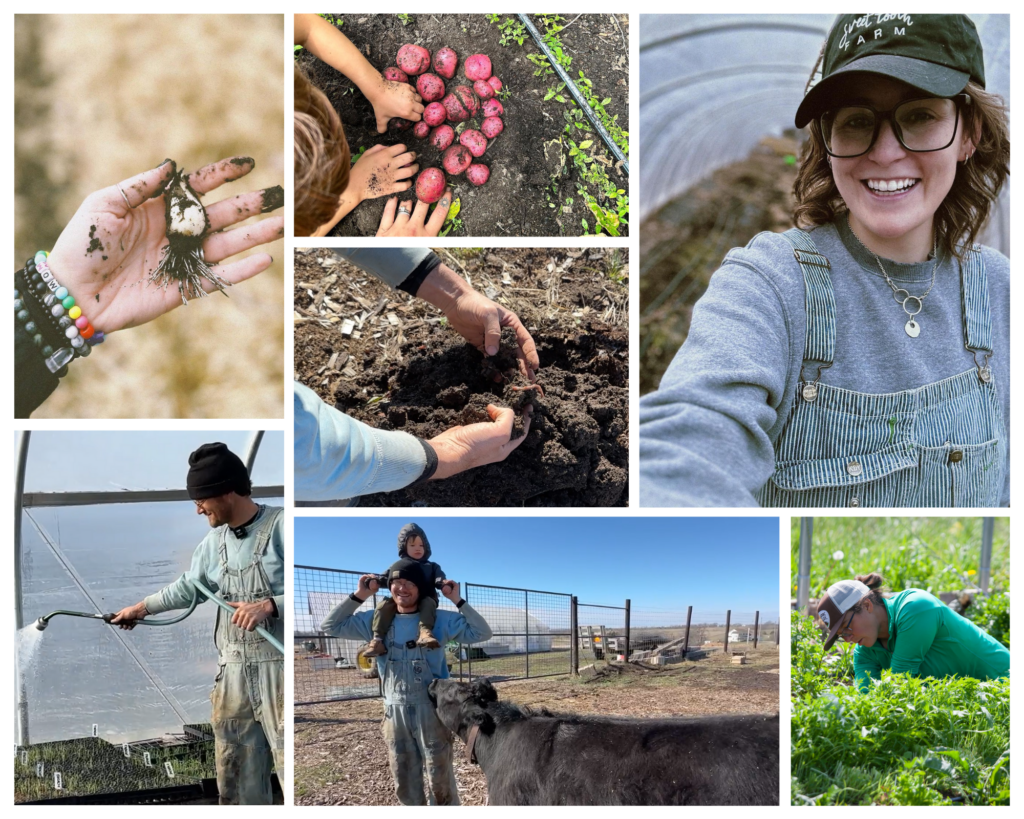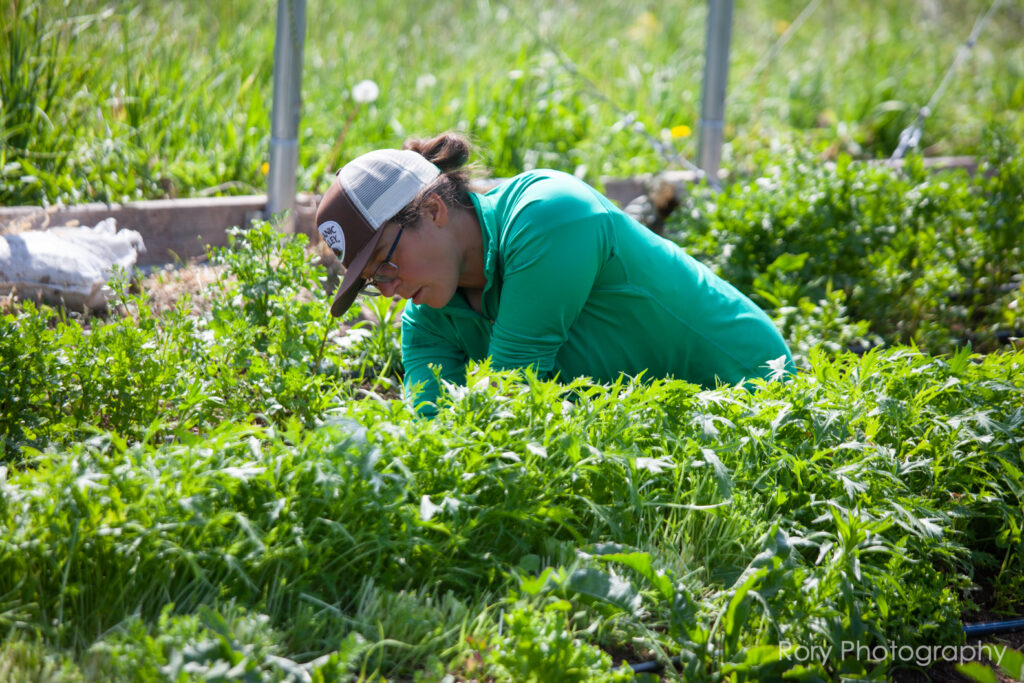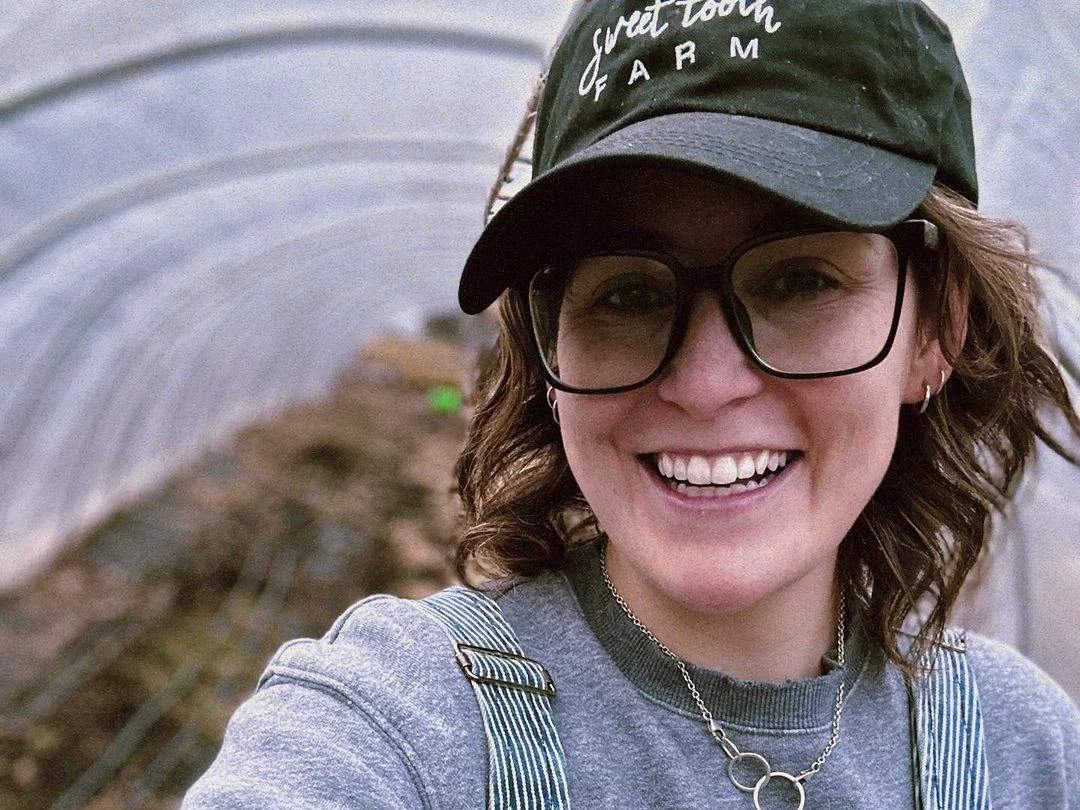New farmers are rethinking traditional practices to break into an otherwise cost-prohibitive industry.

If you’re trying to start your own farm, finding the right piece of land for the right price can seem impossible. Jordan and Whitney Clasen found themselves looking at land with a million-dollar-plus price tag—well outside of their budget. Jordan had started farming using land rented from his high school best friend’s parents. But when they told Jordan they wanted to sell that land, he had to find a new place to farm.
It was a struggle. The parcels the couple found were either too expensive or didn’t meet their criteria. It got so bad they thought about buying a small number of acres, living in a trailer, and building a barn.
“We looked at so many different options,” Whitney says. “If you don’t have family land, family financial help, or a million dollars—there’s a reason why young people aren’t getting into this profession as much, because it’s just so expensive.”
The Clasens had to lean on an organization called SILT— the Sustainable Iowa Land Trust, a nonprofit that aims to preserve farmland. Farmers can buy land at a discount, but it comes with a catch, namely a conservation easement, a legal agreement that permanently limits what future owners of the land can do with it. A landowner can use an easement to keep their land in conservation farming, but the new owner gets a discount as high as 40% off on the land. That was perfect for the Clasens, who prefer regenerative agriculture, aiming to leave the land better than they found it.
At Grade A Gardens, their 25-acre vegetable and livestock farm in Earlham, Iowa, just outside of Des Moines, they grow over 100 crop varieties. They also run events on their farm, including an annual garlic festival and U-Pick Days, when members of the public can pick produce from the fields for a discounted price. Grade A took years to grow into what it is today.
“You gotta have a lot of grit,” Whitney says. “…Things don’t always happen as quickly or as smoothly as you would like them to.”
Young farmers and alternative approaches struggle to take root in Iowa
Being a farm state is part of Iowa’s identity—farms cover over 90% of the state. For that to continue, though, Iowa needs young farmers. The average age of Iowa’s farmers hit 57.6 in 2017. But for those looking to enter the industry, particularly new and young farmers, it’s difficult to get started. One big reason: land. It’s just unaffordable.
As of March 2024, high quality crop ground cost $14,485 per acre, according to Amanda Van Steenwyk, the farm business development manager at the Iowa Farm Bureau. To get enough land to count as an average-sized farm in the state—359 acres, according to a 2023 USDA report—would cost over $5.2 million. It’s no wonder a 2022 survey conducted by the National Young Farmers Coalition found that 59% of farmers 40 and under said finding affordable land to buy was “very or extremely challenging.”
“If you’re operating a farm and maybe you’re in your 50s closing in on that retirement age, it’s still expensive. So there’s a lot of barriers to entry,” Van Steenwyk says.
Even more so if you want to farm sustainably or something other than Iowa’s two main crops, corn and soybeans. Around three-quarters of Iowa’s cropland is used to grow corn and soybeans, which generally ends up as animal feed, processed foods, and ethanol fuel. Iowa farming contributes substantially to greenhouse gas emissions, with Iowa ranking second in the nation for greenhouse gasses from agriculture, according to data published by The Gazette and Investigate Midwest. And the farming practices used to grow corn and soybeans have also eaten away at the richness of the state’s soil and lowered water quality.
Beth Hoffman, author of Bet the Farm: The Dollars and Sense of Growing Food in America, thinks there needs to be more options and opportunities for young farmers and those interested to get into the industry. She spent more than two decades as an agriculture journalist and professor. She says the farming industry isn’t set up to grow things outside of row crops like corn and soybeans. This includes government support through subsidized insurance payments, scientific research, and the infrastructure within the system. Hoffman doesn’t fault people for growing corn and soybeans.
“The system is set up [so] that is what a farmer can most easily and often profitably do,” Hoffman says.
To farm another way, you could use the help of a land access navigator like Amber Mohr. She works for Practical Farmers of Iowa, helping beginning farmers get their start, including those who don’t have much experience. Mohr says sustainable farming practices take more time and start-up costs, but usually, they eventually pay for themselves. She says farmers cite all kinds of different reasons for getting into farming.
“It’s usually not [for] profit,” Mohr says. “It’s usually people who want a lifestyle change, or they want to contribute to their community with local food.”

Reimaging Family as a Business Model
Helping hands make a world of difference on a farm. Hannah Breckbill and Emily Fagan’s farm has a collaborative model that has made it more resilient. The second cousins run Humble Hands Harvest, a worker-owned cooperative farm in Decorah, a small city in northeast Iowa. It’s truly a shared operation. By pooling resources, Breckbill and Fagan have increased their financial power. They have more connections to support systems they need. And the duo makes decisions by consensus, including whether to eventually become a trio.
Breckbill and Fagan haven’t brought on another co-owner yet, but their employees have the potential to become one. They’re currently hiring for 2024. You might compare it to dating with the potential of getting married. Cooperative farming has similarities with family relationships, Breckbill says. And a farming family doesn’t have to be a heterosexual, nuclear family.
“I have to reimagine family anyway,” says Breckbill, who is queer, “so I get to do that with co-farmers, and that’s really fun.”
Collaborative farming can have many benefits, although it’s important to take precautions to make sure the arrangement works out well for everyone. Farming has been done collaboratively for most of human history, according to a 2019 article in Intelligencer. But there aren’t very many collaborative farms in Iowa, Breckbill says.
“The kind of obsession that Americans have with land ownership is a thing that kind of drives this individual way of farming,” Breckbill says. “And a lot of other places around the globe don’t have that same conception or obsession with land ownership. I went to Oaxaca, Mexico, a number of years ago, and learned about their Indigenous communities. The entire community owns the land.”
When workers can be part of owning a farm and making decisions about its future, they’re going to feel empowered, Breckbill says. She thinks it’s good for workers to feel they can make a difference in their work lives and their communities.
“I think that’s one huge potential result of more collaborative and cooperative work, is just, like, a stronger democratic society,” Breckbill says.

The challenges of urban farming
One solution to the land crisis has been to convert empty plots of urban land into food-producing farms. These urban farms provide green space and access to fresh food, often for areas that have been historically disadvantaged. Urban farms can look different, from multiple sites within a city limit to an unused rooftop turned into a garden. The USDA reported that the average size of an urban and suburban farm is nine acres, although 37% of farms reported less than an acre.
Monika Owczarski sees providing produce to her neighborhood—from her urban farm to Des Moines’ first ever community fridge—as a responsibility.
“I am so grateful that I went down this path,” Owczarski says. “The life and the things that we’ve been able to build for our neighbors, for our family, and for the city, I think wouldn’t have existed [if I hadn’t]. Or at least, would have [happened] much later.”
It started with an abandoned park next to her house in the River Bend neighborhood, Owczarski says. Where some might have seen an abandoned plot of land, Owczarski saw an opportunity.
In 2016, Owczarski started leasing the land from the city’s Parks and Recreation Department, turning it into Sweet Tooth Farm. She admits that during the first year, she didn’t really know what she was doing. Although she had years of gardening experience, scaling up to an urban farm came with its own challenges. Those challenges became a good lesson to learn, improving her skills and learning what her market was.
All of that changed in 2021 when the city told Owczarski that she wouldn’t be able to farm on more than an acre of land she leased in the Central Place and Valley Gardens industrial parks and she’d need to vacate after one more season as that land was going towards development. She was able to keep her River Bend land as it is technically under the Parks department’s authority.
“[It was] deeply sad,” Owczarski says. “Before we were on that space, it had not been touched or leased or used by anyone since 1979.”
Losing that land impacted how Sweet Tooth Farm operated and forced them to pivot. At her peak, she was producing over 40,000 pounds of food on more than two acres of land throughout Des Moines. Now she’s down to 10,000 pounds on four plots scattered across the city. With less land available to harvest, she couldn’t grow enough food to be able to sell produce at the farmer’s market and to restaurants.
“There reaches a point at which it makes sense and you’re able to make some money, but it was to the point where we were losing money,” Owczarksi says. “I was working 16-18 hour days. I never saw my children and it was just—it was a losing battle.”
Except for what makes it onto her kitchen table, everything Owczarski farms now goes into the community fridge. It started during the COVID-19 pandemic in 2020. Owczarski’s River Bend neighborhood is a food desert—a neighborhood where access to fresh or affordable food is limited. The fridge was created to both help those in the local community get healthier food options after food pantries and other food assistance programs closed and solve a distribution problem for the farm, since Owczarski had nowhere to take produce to stay fresh during Covid.
Currently, Sweet Tooth Farm participates in the Iowa Local Food Purchasing Assistance Program, meaning another nonprofit pays them a small fee to put food in the fridges.
“Essentially it’s just enough to basically break even and keep the lights on and pay the leases and buy seeds,” Owczarski says. “And that’s all I need it to be right now.”
Despite all the challenges she has faced, she is grateful that she started Sweet Tooth. She also understands the privilege she has as a White woman, and feels a sense of responsibility due to the history of farming being built on slave labor. She serves as an advisor for a USDA Urban Agriculture Committee where she uses her voice to advocate for others.
“I am able to use my voice in rooms and in spaces, that my colleagues who may be Black or brown, maybe queer, maybe don’t have land,” Owczarski says. “…To really push and use my voice, I think would not have happened if I hadn’t been hoofing it out there…I’m really grateful for that.”
